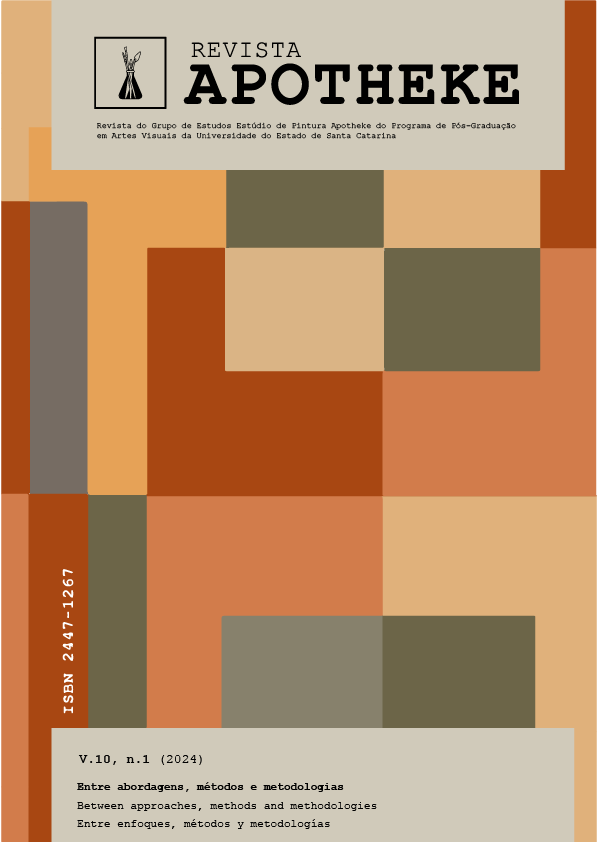Words-images-words: a methodological path for teaching art
DOI:
https://doi.org/10.5965/244712671012024013Keywords:
teaching, memory, teaching visual arts, words-images-wordsAbstract
The first-person narrative is how to write this research, not in a personalized first person, but beyond my experiences related to my experiences. Carrying out this research involves my understanding of teaching, when I report experiences that did not distance me as an observer of this world and I situated myself as living in a place that I consider to be lands-landscapes-lands. Places embraced by the anxieties of research, of teaching, surrounded by absences, emptiness, doubts and uncertainties that are not just my characteristics, but that can be born in the encounter with the readers of this research. I explain how I create metaphors to make clear what I understand and how to think about words and images such as land and landscapes. Teaching and student experiences are lands that are taken to other spaces where they are given new meaning in places that will soon transform. I understand with Tuan (1983) that these spaces and places are not just surrounding geopolitical factors and I share the idea of social, historical and cultural living with the subjectivities of each individual. I refer to my encounter with texts that showed me how I create and appropriate words from words-images-words in a contemporary teaching perspective. In these reflective moments discovered with Magritte, in Foucault’s text (1988), through the system of verbal and visual representation in search of similarities and similarities, with Beck (2004) that the system of meanings proposes a path to possible thought. And in dialogue with Didi-Huberman (2010) I understood a little more about the interaction with the image. Thus, the proposal presented in this research presents a methodological path to think about teaching art with words-images-words.
Downloads
References
BECK, Ana Lúcia. Palavras fora do lugar: Leonilson e a inserção de palavras nas artes visuais, 180 f. Dissertação (Mestrado em Artes Visuais) – Universidade Federal do Rio Grande do Sul, Porto Alegre, 2004. Disponível em: http://hdl.handle.net/10183/77868 Acesso em: 12 ago. 2021.
DIDI-HUBERMAN, G. O que vemos, o que nos olha. Tradução de Paulo Neves. 2. ed. São Paulo: Editora 34, 2010.
FOUCAULT, Michel. As palavras e as coisas. São Paulo: Martins Fontes, 2016.
FOUCAULT, Michel. Isto não é um cachimbo. Rio de Janeiro: Paz e Terra, 1989.
TUAN, Yi-Fu. Espaço e lugar: a perspectiva da experiência. Tradução de Lívia de Oliveira. São Paulo: Difel, 1983. p.260.
Downloads
Published
How to Cite
Issue
Section
License
Copyright (c) 2024 Lara Maria de Melo Dias, Valéria Fabiane Braga Ferreira Cabral

This work is licensed under a Creative Commons Attribution-NonCommercial 4.0 International License.
Copyright and Licensing Policy
Authors of works submitted to Revista APOTHEKE authorize their publication in both print and digital formats exclusively for academic purposes. Reproduction is permitted, provided that the source is properly cited. Authors confirm the originality, authorship, and unpublished status of their manuscripts.
Articles published by the journal are freely available and intended for academic and non-commercial use only. All copyrights are transferred to the journal. The content of signed articles reflects the views of their respective authors and not the official position of Revista Apotheke. The author(s) agree to always cite the following reference when republishing or referring to the content originally published in Revista Apotheke:
“This article was originally published by Revista Apotheke in volume (insert volume), number (insert number), year (insert year), and is available at: http://www.revistas.udesc.br/index.php/APOTHEKE/index”
It is the sole responsibility of the authors to obtain written permission for the use of any material protected by copyright law included in their articles. Revista Apotheke is not responsible for copyright infringements committed by contributors.
Authors retain copyright and grant the journal the right of first publication, with the work licensed under a Creative Commons Attribution-NonCommercial License (CC BY-NC):
-
Attribution (BY): Licensees are allowed to copy, distribute, display, perform, and create derivative works, provided that proper credit is given to the author or licensor, in the manner specified.
-
NonCommercial (NC): Licensees may use the material only for non-commercial purposes.
After publication, authors retain the rights to their work and may republish the text.



